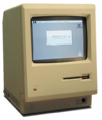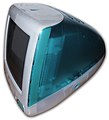All-in-one computer
An all-in-one computer is a stationary computer in which the motherboard and monitor part are housed in a common housing. In addition, the term is restricted to desktop computers , as it always applies to all mobile devices such as notebooks , tablet computers and portables .
Advantages and disadvantages
An important advantage of this design is that the error-prone and often unsightly cabling is largely eliminated. In addition, the power consumption is reduced compared to individual components if notebook components or at least low-consumption components are used in the construction. However, these are usually a little less powerful, but also produce less waste heat, so that annoyingly loud fans can often be dispensed with.
If an optical drive is missing, an external drive with a USB connection must be used.
history
The term all-in-one was not used in the first devices of this type. There were, for example, systems from IBM ( 5100 series , 1975), the early models from Commodore ( PET 2001 from 1977, as well as the subsequent CBM series) and Tandy ( TRS-80 models 3 and 4, 1980 or 1983), which even the keyboard was firmly integrated into the housing. IBM referred to its 20 to 48 kilograms heavy devices in terms of cabinet-sized minicomputers as "portable" computers.
In 1984 the Apple company not only presented the first graphically controlled computer for the mass market, but also the most famous all-in-one computer of all time, the very compact Macintosh . While this cube-like housing shape - apart from one model from the moderately successful IBM PS / 2 series - received no attention from competitors, Apple kept offering computers of this type until the 1990s. However, Apple's market share outside of the creative industry was small at the time and the company was close to bankruptcy.
That changed when Apple released the iMac in 1998, an all-in-one device that was immediately successful and is now considered one of the company's saviors. This model series, which is designed for compactness and pleasing design , is continued to this day. Over time, the basic shape of the housing changed with the advent of flat screens and higher miniaturization , away from the cube and towards the monitor with an inconspicuous flat-panel computer behind it.
Current developments
Apple's increasing success in the consumer market in the 2000s, not least due to popular products such as the iPod and iPhone , enticed other manufacturers such as Asus , Dell or Sony to also use PCs in a space-saving all-in from around 2010 -one construction offer. Unlike Apple, many of these manufacturers also integrate a touchscreen into their products.
See also
- Apple iMac
- Commodore PET 2001 (historical)
- IBM 5100 (historical)
Web links
- Andrej Sokolow: All-in-One-PC - desk beauties. In: Spiegel Online, January 27, 2011. On Spiegel.de, accessed on January 20, 2019.



